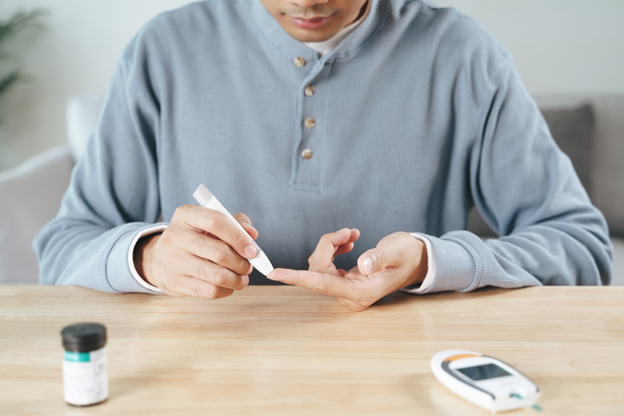Introduction
Type 2 diabetes is a chronic medical condition that affects how the body processes blood sugar (glucose). Unlike type 1 diabetes, where the body’s immune system attacks insulin-producing cells, type 2 diabetes develops when the body becomes resistant to insulin or doesn’t produce enough of it. As a result, glucose builds up in the bloodstream, leading to high blood sugar levels.
This form of diabetes is often linked to lifestyle factors, such as poor diet, lack of physical activity, and obesity, although genetics also play a role. In this blog, we will discuss the causes, symptoms, risks, and management of type 2 diabetes, as well as strategies for preventing the disease.
What Causes Type 2 Diabetes?
Type 2 diabetes develops when the body’s insulin system becomes less effective, resulting in elevated blood sugar levels. Insulin is a hormone that helps cells absorb glucose from the bloodstream for energy. In type 2 diabetes, the body either:
- Becomes Resistant to Insulin: The body’s cells become less responsive to insulin, meaning they don’t absorb glucose effectively.
- Produces Insufficient Insulin: Over time, the pancreas can lose its ability to produce enough insulin to maintain normal blood sugar levels.
There are several risk factors that contribute to the development of type 2 diabetes:
- Obesity: Excess fat, particularly around the abdomen, is one of the primary risk factors for insulin resistance.
- Sedentary Lifestyle: Lack of physical activity contributes to weight gain and insulin resistance.
- Age: The risk of developing type 2 diabetes increases with age, particularly after 45.
- Family History: A family history of diabetes increases the likelihood of developing the condition.
- Ethnicity: African American, Hispanic, Native American, and Asian American populations are at a higher risk of type 2 diabetes.
Symptoms of Type 2 Diabetes
Many people with type 2 diabetes may not experience symptoms initially. When symptoms do occur, they can be subtle and may include:
- Increased thirst and frequent urination
- Extreme fatigue
- Unexplained weight loss
- Blurry vision
- Slow-healing sores or infections
- Numbness or tingling in the hands or feet
- Dark patches of skin, especially around the neck or armpits (a condition called acanthosis nigricans)
If you experience any of these symptoms, it’s important to seek medical advice, as early detection and management can prevent serious complications.
Managing Type 2 Diabetes
While there is no cure for type 2 diabetes, the condition can be managed effectively through a combination of lifestyle changes, medication, and monitoring. Here are the key strategies:
- Healthy Diet:
A balanced diet is crucial for managing blood sugar levels. Focus on eating whole foods, including vegetables, fruits, lean proteins, and whole grains. Limit processed foods, sugary snacks, and refined carbohydrates, which can cause blood sugar spikes. - Regular Physical Activity:
Exercise helps improve insulin sensitivity and control blood sugar levels. Aim for at least 150 minutes of moderate-intensity exercise per week, such as brisk walking, swimming, or cycling. - Weight Management:
Losing even a small amount of weight can significantly improve insulin sensitivity and reduce blood sugar levels. A combination of diet and exercise is the most effective approach for weight loss. - Medications:
In some cases, lifestyle changes alone may not be enough to manage type 2 diabetes, and medications may be prescribed. Common medications include metformin, sulfonylureas, and SGLT2 inhibitors. Your healthcare provider will recommend the best treatment plan based on your specific needs. - Blood Sugar Monitoring:
Regular blood sugar monitoring is essential for keeping track of your glucose levels. Home glucose meters are available, but your doctor may also perform A1C tests to assess your long-term blood sugar control.
Preventing Type 2 Diabetes
Preventing type 2 diabetes is possible, particularly if you are at high risk. Here are some key strategies:
- Maintain a Healthy Weight:
Even modest weight loss can lower your risk of developing type 2 diabetes. - Stay Active:
Exercise regularly to improve insulin sensitivity. - Eat a Balanced Diet:
Focus on a diet rich in fiber, vegetables, lean proteins, and healthy fats. - Avoid Smoking:
Smoking increases your risk of diabetes and other health complications. - Monitor Blood Sugar Levels:
If you have prediabetes, regular monitoring and lifestyle changes can help prevent progression to type 2 diabetes.
Conclusion
Type 2 diabetes is a serious condition that requires careful management. By adopting a healthy lifestyle, monitoring blood sugar levels, and working with healthcare professionals, people with type 2 diabetes can lead healthy, active lives. Prevention is possible through weight management, exercise, and proper nutrition, making it essential to take steps early to reduce your risk of developing diabetes.
Consult us today at Olympus Hospitals for expert guidance!


